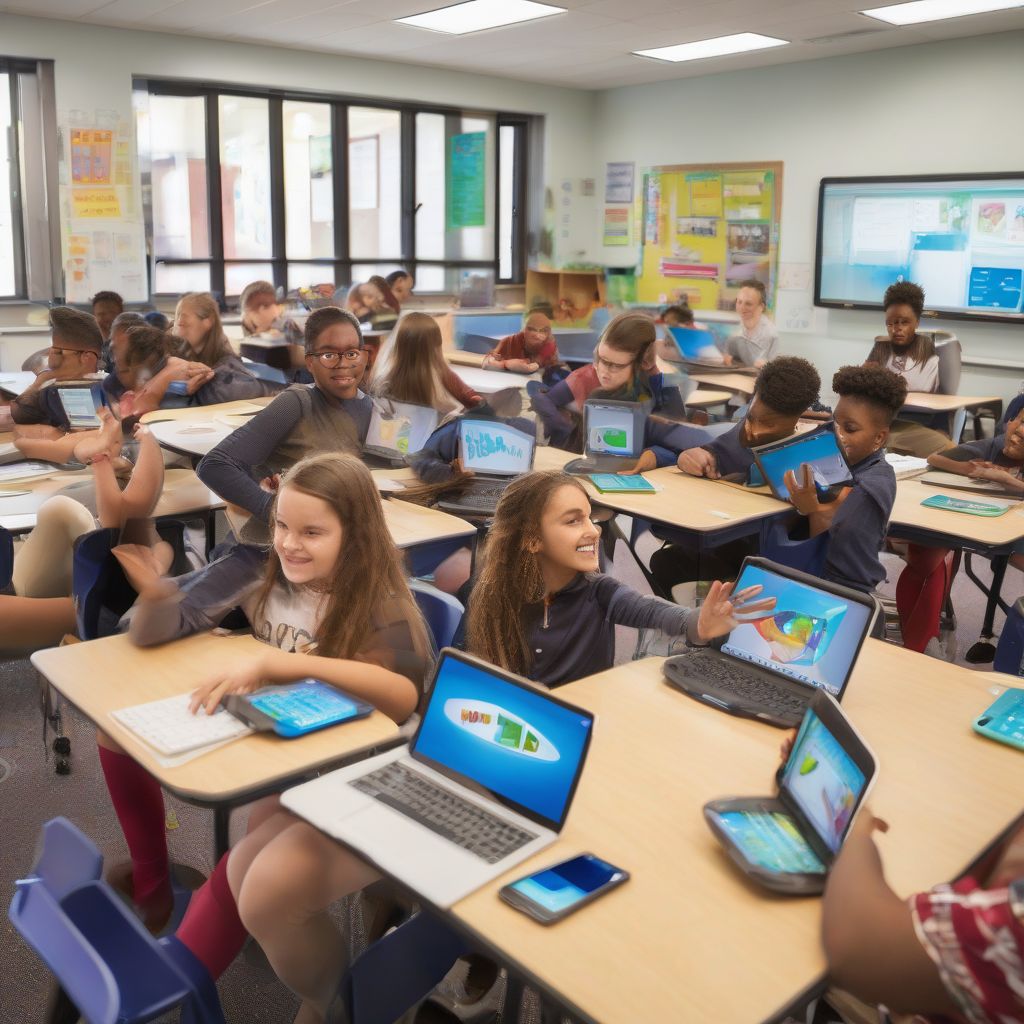Remember those days of lugging around hefty textbooks, struggling to stay awake during monotonous lectures, and painstakingly copying notes from a chalkboard? Those days are becoming a distant memory thanks to the transformative power of technology in education.
 Modern Classroom with Technology Integration
Modern Classroom with Technology Integration
From kindergarten to higher education and beyond, technology is revolutionizing the way we learn, teach, and approach education. It’s not just about replacing textbooks with tablets; it’s about creating engaging, personalized learning experiences that cater to individual needs and prepare students for the digital future.
Breaking Down Barriers: Access and Opportunity
One of the most significant impacts of technology on education is its ability to democratize learning and break down geographical barriers. Online courses, virtual classrooms, and digital learning resources have made quality education more accessible than ever before.
-
Distance learning: No longer limited by location, students in remote areas or with physical limitations can access a wealth of educational opportunities through online platforms. This flexibility allows individuals to pursue higher education or vocational training while balancing work, family, or other commitments.
-
Global classrooms: Technology facilitates collaboration and communication, connecting students and educators from across the globe. Virtual exchange programs, collaborative projects, and online forums foster cross-cultural understanding and global citizenship.
Personalized Learning: Catering to Individual Needs
Imagine a classroom where every student learns at their own pace, focusing on their strengths and receiving targeted support in areas where they struggle. Technology makes this personalized learning experience a reality.
-
Adaptive learning platforms: Software programs and apps can assess a student’s understanding of a concept and tailor the learning materials accordingly. This individualized approach ensures that students are appropriately challenged and supported, maximizing their learning potential.
-
Diverse learning styles: Technology caters to a variety of learning preferences. Visual learners can benefit from interactive simulations and videos, while auditory learners can engage with podcasts and audiobooks. Kinesthetic learners can participate in virtual labs and hands-on online activities.
Engagement and Motivation: Sparking a Passion for Learning
Let’s face it, traditional lectures and textbook learning can sometimes be, well, a little dry. Technology has the power to inject excitement and engagement back into the learning process.
-
Interactive learning: From gamified educational apps to virtual reality field trips, technology makes learning fun and immersive. These interactive experiences capture students’ attention and foster a deeper understanding of the subject matter.
-
Real-world connections: Technology bridges the gap between the classroom and the real world. Students can access up-to-date information, connect with experts in various fields, and participate in project-based learning experiences that mirror real-world challenges.
21st-Century Skills: Preparing for the Future
In today’s technology-driven world, it’s crucial to equip students with the skills they need to thrive in the digital age. Technology integration in education goes beyond just using devices; it’s about developing critical thinking, problem-solving, and digital literacy skills.
-
Critical thinking and problem-solving: Technology allows students to analyze information from various sources, evaluate its credibility, and synthesize their own conclusions. This development of critical thinking skills is essential for navigating the information overload of the digital age.
-
Collaboration and communication: Online platforms and collaborative tools encourage students to work together, communicate effectively, and develop teamwork skills essential for success in the modern workforce.
-
Digital literacy and citizenship: As students navigate the digital world, it’s essential to teach them responsible technology use, online safety, and ethical considerations surrounding technology.
The Challenges of Technology Integration
While the benefits of technology in education are vast, it’s important to acknowledge and address the challenges that come with integration:
-
Digital divide and equity: Not all students have equal access to technology and reliable internet connectivity. Bridging this digital divide is crucial to ensure equitable educational opportunities for all.
-
Teacher training and support: Educators need ongoing professional development to effectively integrate technology into their teaching practices. Providing teachers with the necessary training, resources, and support is essential for successful technology adoption.
-
Balancing screen time and well-being: It’s important to find a healthy balance between screen time and other activities. Promoting responsible technology use and encouraging students to engage in offline activities is essential for their well-being.
The Future of Education: Embracing the Potential of Technology
The integration of technology in education is an ongoing journey, and its impact will continue to evolve. As we move forward, it’s crucial to embrace the potential of technology to create more engaging, equitable, and effective learning experiences for all students.
By addressing the challenges, investing in teacher training, and promoting responsible technology use, we can harness the power of technology to empower the next generation of learners and prepare them for a bright future.
[amazon bestseller=”educational technology books”]
